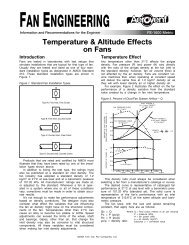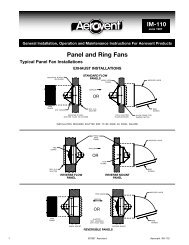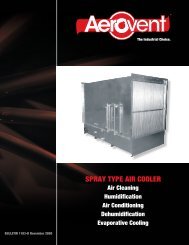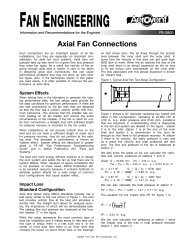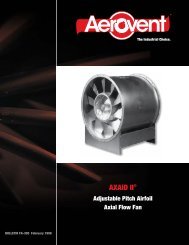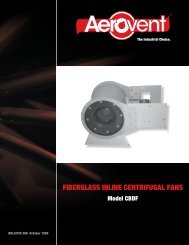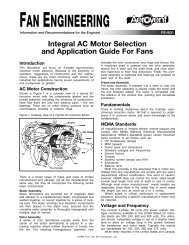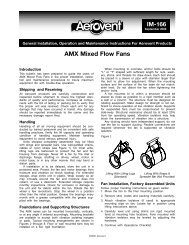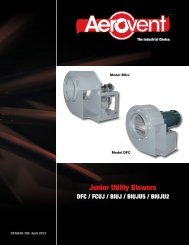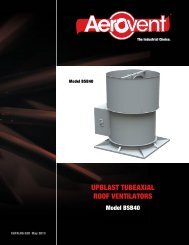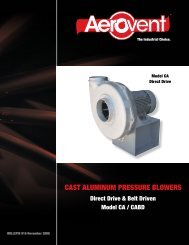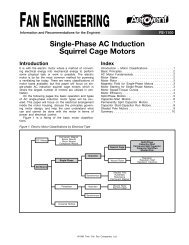Fan Performance Characteristics of Centrifugal Fans - Aerovent
Fan Performance Characteristics of Centrifugal Fans - Aerovent
Fan Performance Characteristics of Centrifugal Fans - Aerovent
- No tags were found...
Create successful ePaper yourself
Turn your PDF publications into a flip-book with our unique Google optimized e-Paper software.
Figure 4. Tip Speed/Static Pressure RelationshipRPM — HUNDREDSSTATIC PRESSURE — IN. W.G.454035302520151050.90.80.70.60.50.40.30.20.1Forward Curve <strong>Fan</strong>sWHEEL DIA. INCHES2 34F R BThese fans are sometimes known as “volume,” “squirrelcage,” or “sirocco” blowers. The impeller blades aresmall and numerous with a pronounced curvature andshort chord length. The concave blade curvature facesthe direction <strong>of</strong> rotation. These fans operate at relativelylow speeds and pressures (reference Figure 4)which permits light construction <strong>of</strong> the impeller, shaft,bearings, and housing.681012162030BLADE INCLINATIONF = FORWARDR = RADIALB = BACKWARD1 2 3 4TIP SPEED — FPM (THOUSANDS)The forward curve fan is used to deliver high air volumesagainst static pressures up to 6" water gauge.However, the majority <strong>of</strong> applications are for pressures <strong>of</strong>3" water gauge or less. Note the pronounced dip (stall)in the static pressure curve (Figure 5b). Any selection tothe left <strong>of</strong> the 40% free delivery point (peak) will resultin an unstable pulsating airflow that will lead to impellerand structural damage. Even though good peak efficienciesare on either side <strong>of</strong> the peak, selections should belimited to 45% or greater <strong>of</strong> free delivery.Interestingly, in parallel installations, if selected tooclose to peak, forward curve fans exhibit a tendency notto share the load equally and become unstable. Theseselections should be limited to 55% or greater <strong>of</strong> freedelivery.The advantage <strong>of</strong> the forward curve fan is its low speedand quiet operation. The light construction results in a lowcost fan and its relatively high airflow results in a smallfan requiring minimum space, making it ideal for the residentialand commercial heating and cooling market.Disadvantages are that its high horsepower requirementsat or near free delivery (note the rising powercurve in Figure 5b) and its light construction limit itssuitability for most industrial requirements.Highly dependent on the housing for performance, theforward curve impeller is not suitable for plug or plenumfan applications. Without a housing the forward curveimpeller becomes unstable and exhibits a relatively poorperformance.Backward Inclined <strong>Fan</strong>sThese are sometimes called “load limiting” or “non-overloading”fans. The impeller blades are larger and heavierthan forward curve blades, usually number from eight totwelve, and are inclined away from the direction <strong>of</strong> rotation.They are standardly <strong>of</strong>fered in three blade shapes:1. Flat single thickness (Figure 6a)2. Curved single thickness (Figure 6b)3. Curved airfoil (Figure 6c)Figure 6. Backward Inclined <strong>Fan</strong>sFigure 5a. Typical Forward Curve <strong>Fan</strong>6a. Flat Single Thickness, BIFigure 5b. Characteristic <strong>Performance</strong> <strong>of</strong> Forward Curve <strong>Fan</strong>s100PERCENT OF NO FLOW STATIC PRESSUREHORSEPOWER AND EFFICIENCY908070605040302010HORSEPOWERSTATIC EFFICIENCYTOTAL PRESSURETOTAL EFFICIENCYSTATIC PRESSURE6b. Curved Single Thickness, BC00 10 20 30 40 50 60 70 80 90 100PERCENT OF FREE DELIVERY6c. Curved Airfoil, BIAPage 2<strong>Fan</strong> Engineering FE-2400
Backward inclined fans are used to deliver mediumto high airflow at static pressures up to 20" watergauge. Pressures up to 40" water gauge are attainablewith special construction.The normal selection range for quiet, efficient performanceis from 40% to 85% <strong>of</strong> free delivery (Figure 7).While these fans do not exhibit a deep stall range likethe forward curve fan, there is a range <strong>of</strong> instability left<strong>of</strong> peak. The single thickness blades are more sensitiveto the breakaway airflow in this area than the airfoil andshould be selected to the right <strong>of</strong> peak.Figure 7 shows the characteristic <strong>of</strong> a flat bladedesign; however, it typifies the characteristics <strong>of</strong> theentire family <strong>of</strong> backward inclined blade shapes. Onlysubtle differences exist between their static pressurecurves.Figure 7. Characteristic <strong>Performance</strong> <strong>of</strong> Backward InclinedFlat Blade <strong>Fan</strong>sRadial Blade <strong>Fan</strong>s“Steel plate” or “paddle wheel” are two <strong>of</strong> the commonnames for radial blade fans. The impeller blades aregenerally narrower, deeper and heavier than forwardcurve and backward inclined blades. A radial bladeimpeller usually comprises six to twelve equally spacedflat blades extending radially from the center <strong>of</strong> the hub.These impellers are generally <strong>of</strong> simple design that lendsitself to rugged construction and <strong>of</strong>fers a minimum <strong>of</strong>ledges, etc., for the accumulation <strong>of</strong> dust or sticky materials.There are more variations <strong>of</strong> the radial blade fansthan the forward curve and backward inclined types.Three <strong>of</strong> the more common impellers are illustrated inFigure 8.Figure 8. Common Radial Blade Impellers100PERCENT OF NO FLOW STATIC PRESSUREHORSEPOWER AND EFFICIENCY908070605040302010HORSEPOWERTOTAL EFFICIENCYTOTAL PRESSURESTATIC PRESSURESTATIC EFFICIENCY00 10 20 30 40 50 60 70 80 90 100PERCENT OF FREE DELIVERYAn attractive feature <strong>of</strong> the backward inclined typesis the non-overloading characteristic <strong>of</strong> their horsepowercurves. As Figure 7 illustrates, the horsepower increasesto a maximum as airflow increases, and then drops <strong>of</strong>fagain toward free delivery. This means that a motorselected to accommodate the peak horsepower will notoverload, despite variations in the system resistance orairflow, as long as the fan speed remains constant.Typically the flat bladed design has efficiencies <strong>of</strong>about 82%, while the curved blade and airfoil designsapproach 86% and 90%, respectively.The backward inclined “family” <strong>of</strong> fans has the highestoperating speeds <strong>of</strong> all the centrifugal fans (Figure4). While this is a desirable feature for direct connectionto modern “high speed” motor or turbine drives, itcomes with a price. Their high operating speed requiresheavier construction and precision balancing, makingthem fairly expensive compared to forward curve fans.Also, the close running clearances required to maintainfan performance makes them unsuitable for materialhandling. However, in single thickness blade constructionthey can be used in light dust and corrosive air.These fans are used primarily in the industrial marketfor ventilation, clean side <strong>of</strong> commercial air cleaningdevices, furnace draft and large commercial heating andcooling units. The air leaving the backward inclinedimpeller has less <strong>of</strong> its total energy in the form <strong>of</strong> velocitypressure than does the air leaving a forward curveimpeller. Because more <strong>of</strong> its energy is in the form <strong>of</strong>static pressure, a backward inclined impeller loses lessenergy in the process <strong>of</strong> converting from velocity pressureto static pressure in the housing. Therefore, abackward inclined impeller can operate quite satisfactorilywithout a housing, making it suitable for specialtyfans such as plug fans, plenum fans, and in-line centrifugalfans, whose characteristics are all similar toFigure 7, just slightly less efficient.8a. 8b. 8c.OW/BW AW RTRadial Blade Air Wheel Radial TipThe open wheel (OW), paddle wheel; and the backplatewheel (BW), steel plate, are the most common <strong>of</strong>the radial blade impellers, and their typical performancecharacteristics are shown in Figure 9. These fans aregenerally selected to operate from 35% to 80% <strong>of</strong> freedelivery. However, it should be noted that these fanscan, and do, operate quite successfully left <strong>of</strong> peak,down to approximately 20% <strong>of</strong> free delivery.Figure 9. Characteristic <strong>Performance</strong> <strong>of</strong> Radial Blade <strong>Fan</strong>sPERCENT OF NO FLOW STATIC PRESSUREHORSEPOWER AND EFFICIENCY100908070605040302010STATIC EFFICIENCYHORSEPOWERTOTAL PRESSURETOTAL EFFICIENCYSTATIC PRESSURE00 10 20 30 40 50 60 70 80 90 100PERCENT OF FREE DELIVERYFrom Figure 4 it can be seen that these are mediumspeed fans and are used to deliver low air volumes atmedium to high pressure. The main advantage <strong>of</strong> theradial blade fan lies in its simple but rugged construction.They are ideal for high static pressure applicationsand for handling airstreams containing a high level <strong>of</strong>particulate.Some <strong>of</strong> the disadvantages are that they generatemore noise than forward curve and backward inclinedfans, primarily because <strong>of</strong> the impeller design and highoperating velocities and they exhibit the same risinghorsepower characteristic as the forward curve fans.Because they are low volume fans, larger sizes aregenerally required, taking up a larger installation space.<strong>Fan</strong> efficiencies are lower than both the forward curveand backward inclined type, but this is generally <strong>of</strong>fsetby their ability to adapt to harsh environments.Page 3<strong>Fan</strong> Engineering FE-2400
For higher efficiencies most manufacturers <strong>of</strong>fer somevariation <strong>of</strong> the air wheel (AW) impeller, Figure 8b, tooperate in the same housing as the straight radial bladeimpellers. For even higher efficiencies and airflow, manufacturersalso <strong>of</strong>fer a radial tip (RT) impeller; however,in most cases the radial tip impeller operates in a housingsimilar to the backward inclined design. The radialtip design fills the gap between the clean air backwardinclined fans and the more rugged radial blade fans.Both the air wheel and the radial tip impellers areideal for contaminated airstreams but neither is intendedfor bulk material handling. Both impellers have pressurecharacteristics similar to the backward inclined impellersand a horsepower characteristic similar to the radialblade and forward curve impellers. Unlike the straightradial blade impellers these two impeller designs doexhibit some instability left <strong>of</strong> peak and should alwaysbe selected to the right <strong>of</strong> peak.By and large, the radial blade series <strong>of</strong> fans are usedexclusively in the industrial market for handling and conveyingvarious process materials and gases. They areused for “high pressure” air systems and for combustionair. Generally speaking, they are furnished in belt drivearrangements due to the high shock loads and harshenvironments to which they are exposed.®<strong>Aerovent</strong> | www.aerovent.com5959 Trenton Lane N | Minneapolis, MN 55442 | Phone: 763-551-7500 | Fax: 763-551-7501



